Introduction:
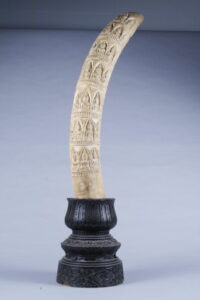
Ivory, a raw material found in the tusks, teeth and bones of animals, most famously elephants. It has been used as a decorative element, whether as wearable jewelry or a sculpture, since ancient times. The craft based around ivory is ingrained in Indian culture and has sustained several generations of carvers. The craft tradition is without a doubt an important part of India’s both tangible and intangible cultural heritage. The constitution also helps in cultural conservation under article 29, but what happens when certain cultural element like ivory craft becomes a threat on the very existence of the environment and animals. This article delves deep into the rise, decline and changes in the Ivory craft of Delhi and the cultural habits around it.
Origins of the Artform:
While there is still debate on exact the time of origin of Ivory craft, archeological evidence shows that it has been a popular luxury item from as long as c. 3000 BCE. Harappan sites (c. 2500-1750 BCE) show the usage of ivory tusks being carved into jewelry, seals, combs, toys, etc. The later period (c. 1700 BCE) saw the institutionalization of craft. As ivory carving became more religiously prominent and sophisticated, several guilds began to emerge, as mentioned in the Rigveda. (It is completely possible that Ivory Guilds existed in the Indus Valley Civilization, but as always, we don’t have literary evidence to prove it.)
India was the hub of Ivory export ever since the ancient world. Even biblical King Solomon (c. 1000 BCE) had a keen interest in it, the Bible mentions trade in Gold, Silver, Ivory, Apes and Peacocks coming from Ophir, a place associated with Indian Port cities. The Susa inscription of Darius I (c. 600 BCE) mentions the usage of Indian Ivory as a trading commodity and in the decoration of his palace in Persia.

The usage of Ivory as a raw material never died down. Along with the discovery of an overwhelming number of artifacts, we also find scattered mentions of this craft from several inscriptions and manuscripts all over India. The Mahabharata and the Ramayana, ancient Indian epics compiled in c. 400 BCE – 400 CE, highlight Ivory decorations several times. Jahangir (1605-1628 CE) in his autobiography, names several of his favorite Ivory carvers and gifts them elephants. European colonizers were also huge admirers of this art and provided incentive for its production.
How it Flourished:
By the turn of the 1st Century CE, ivory was already an important part of religious and ceremonial activities. Almost everything was being made from this raw material. From shoes to sculptures, combs to toys, plaques and tiles, to even ancient back scratchers. The reason for this huge popularity was the easy availability of elephants across India, both domesticated and wild, as well as the generous patronage from kings and elites. And lastly, a huge local and foreign market for Ivory products further helped in the flourishment of ivory craft.

By the time of the Mughal rule, few centers of this art form were evident. According to George Watt, those were Delhi, Murshidabad, Mysore, and Travancore. Delhi, being the seat of power, reached its highest peaks of Ivory Handicraft. Several artisans and craftsman travelled to Delhi in hopes of receiving patronage or a high price for their product. This, in return, influenced Delhi’s craft environment, adding several new decorative motifs and carving techniques to the Ivory craft of the Capital.
Later, frequent documentation under British Rule shows the huge trade. Delhi’s ivory demand was so high that local elephants were not enough, and India became the biggest consumer of imported African ivory. Annually, 234 tons of ivory were being imported from 1820 to 1857. India was also the highest exporter of finished Ivory products from the 1870s to 1957. One authority estimated “90% of the indigenous production was finding its way into foreign countries…”. Thousands and thousands of craftsmen were processing local and African ivory, this process slowed down only with the introduction of environment protective laws from the 1970s, about which we will focus on later paragraph.
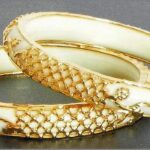
Crafts Using Ivory:
Ivory craft, with the history of over 5000 years, hold unmatched importance in the history of handicraft itself, only being outmatched by allusive pottery. The products certainly holds several years of traditions and habits in their motifs and symbolisms. Some of them are :-
Decorated Bangles: The most common of them, are the usage of Ivory Bangles by Indian women. There are several customs and traditions around it, like being gifted by the maternal uncle to the bride, worn only in the first year of marriage, some tradition dictates to wear it all the time and to be left on them even when they died and were being burned in the funeral pyre, etc. Art historians suggest material was not necessarily ivory, but it was still the most common one.
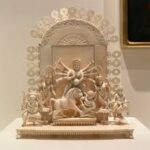

Ambari Hathi : The next most common set of features comes under flora and fauna. The craftsmen have always used their artistic abilities in the depiction of their environment. Several famous designs, namely, Sina Mala, flower motifs; Nari-latavela, creeper patterns; Liya Patha, leaf formations, etc. ironically, the most famous of them all was the intricately decorated royal processional elephant, Ambari Hathi.
Gods and Goddesses : Plaques and sculptures depicting scenes from Hindu, Buddhist and Jain mythologies are also one of the frequent elements found. These carvings were high in popularity due to the patronage from Kings and Religious Institutions, eager to showcase divine authority over their subjects. Famous examples are beautifully carved depictions of Goddess Durga, Laxmi and Kaali, etc.
The Decline and Craft Today:
It is a point to note that this craft was enjoyed for thousands of years and began to be viewed as highly destructive in the last few centuries. It was for this reason that elephants, the source of this material, were always in close proximity. They were one of the most important parts of the empire due to their role in military. According to the Arthashastra, the hunting of elephants was not for sports or enjoyment but for capture and domestication. Many ancient texts (like Ayurveda) show that Ivory was only extracted when elephants died a natural death or when they were periodically cut back into manageable lengths.
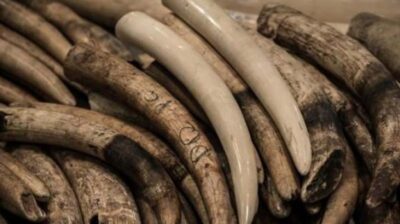
It was due to English industrial practice that Ivory craft reached unsustainable heights. English traders with the motive of profit wanted to produce more and more items and as quickly as possible. As a result, where ancient Indians got ivory from the long process of domestication without killing the animal, they began to be hunted and killed as it was easier and faster.
It was not until the 1970s that bold steps began to be taken for the protection of the animal. The trading, making and processing of raw ivory or ivory products was finally banned in India (Wildlife (Protection) Amendment Act 1986 (Act no. 28 of 1986), 1991 (Act no. 44 of 1991) and 2002 (Act no. 16 of 2003)). This was a huge hit and the final nail in the coffin of ivory craft. But the craft was not completely dead, as illegal poaching and ivory extraction grew. Legally, many carvers shifted to wood and bones of other animals, preserving their technique and a piece of history. Thus, although it changed its way, but it’s not completely dead.
Conclusion:
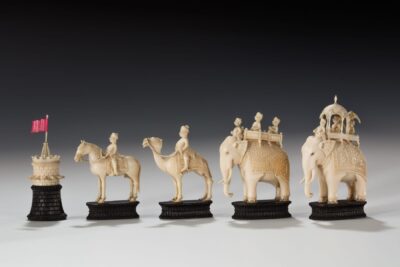
From the hands of humble laborers to the homes of princes and noblemen, ivory craft has witnessed a long journey of India itself. The beauty of their products and skills of their creators got recognition far and wide. Several awe-inspiring items like table ornaments of elephants, camels, horses, and carts; card cases and chess boxes complete with pieces; glove boxes, paper cutters, beds and thrones of emperors; mats woven from threads of ivory and miniature paintings on ivory surfaces; were being created. Today, the stock of ivory artworks is preserved and displayed in museums all across India. This is “an art that has attained marvelous perfection in Delhi.” :- George Watt, Catalogue of Indian Art,1903.
References:
- Martin, E., & Vigne, L. (1989). The decline and the fall of India’s ivory industry. Pachyderm, 12(1), 4–21.
- Saha, Sudipa et al. (2021). Cultural Heritage Management of the Traditional Crafts Using Vulnerable Natural Resources. Heritage: Journal of Multidisciplinary Studies in Archaeology 9, 2021-22, 872-908.
- Rohatagi, Jolly. Crafts and Craftspeople of Shahjahanabad. Sahapedia.org.
- Ivory Work in India. Art & Crafts of India. Culturopedia.com




